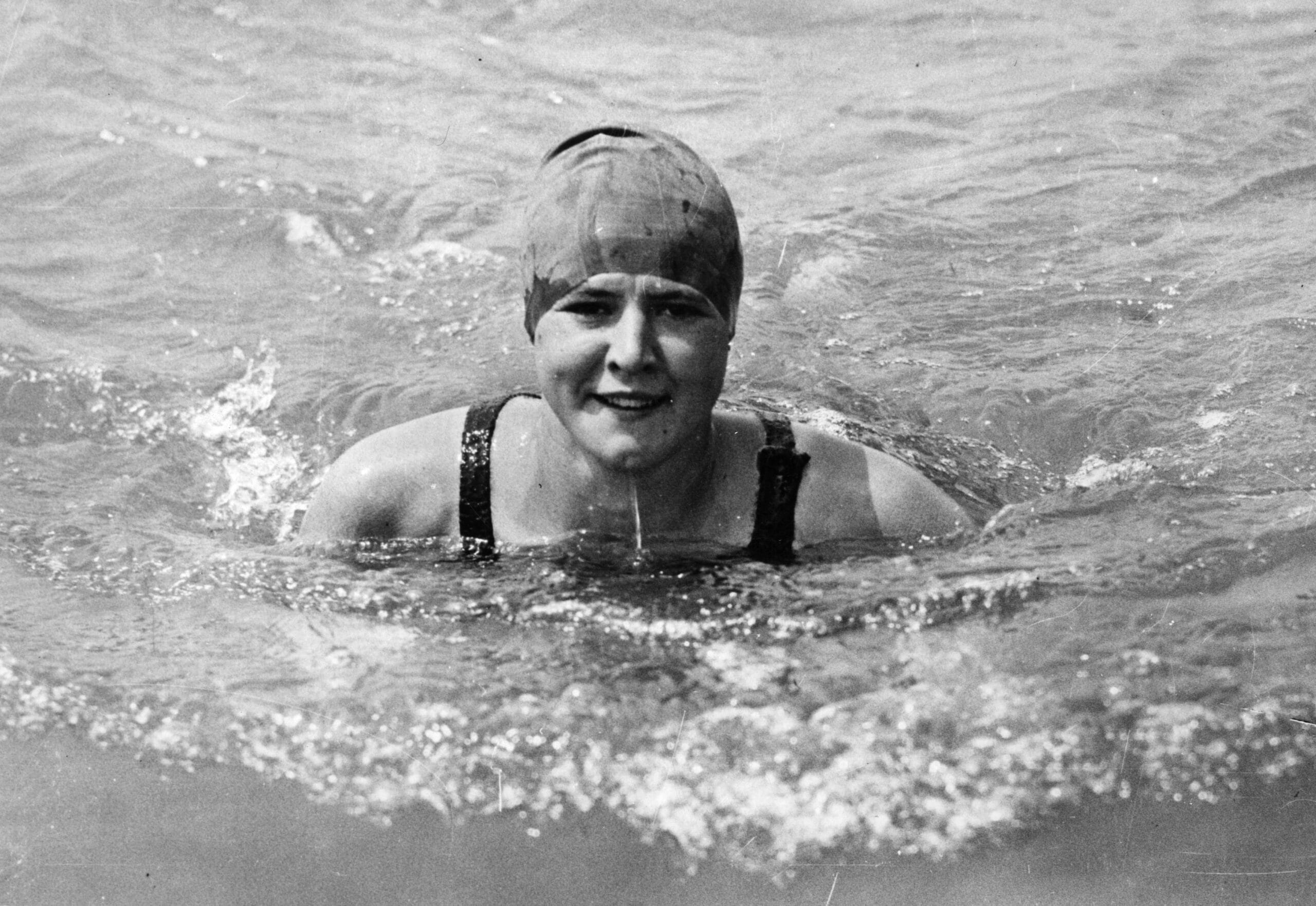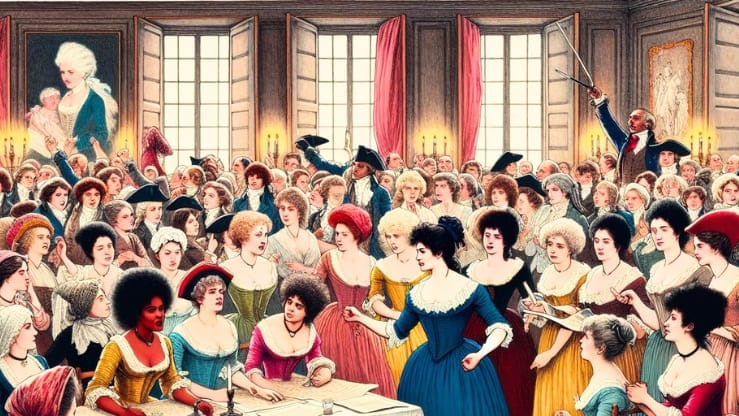Born on October 23, 1905, in New York City, Gertrude “Trudy” Ederle emerged as a trailblazing figure in the annals of women in sports. Raised in a time when societal norms restricted women’s participation in many public spheres, Ederle’s early life was a confluence of passion and pioneering spirit. The daughter of German immigrants, she grew up in a bustling urban environment, which laid the foundation for her remarkable journey.
Trudy Ederle’s affinity for water became apparent in her early years. As a young girl, her family frequently visited the Jersey Shore, where she developed a fervent love for swimming. This passion for aquatic pursuits, uncommon for women of her time, set her apart from her contemporaries. Ederle’s dedication was evident as she joined the Women’s Swimming Association, an organization that fostered female participation in competitive swimming.
The 1920s, an era marked by the burgeoning women’s suffrage movement and shifting social dynamics, significantly influenced Ederle’s ambitions. Her determination to excel in a male-dominated sport resonated with the broader feminist ideals of independence and equality. She quickly rose to prominence, setting 29 national and world records between 1921 and 1925, a testament to her exceptional skill and unwavering resolve.
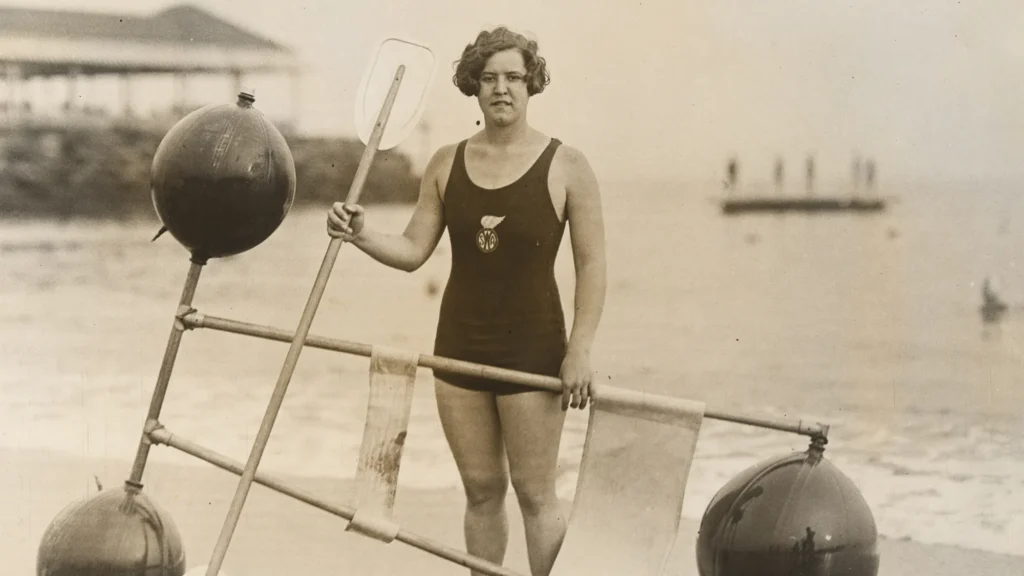
Ederle’s pursuits transcended mere athleticism; they embodied the spirit of the Roaring Twenties, a period characterized by social change and the vigorous redefinition of women’s roles. Her quest was not without challenges, but her tenacity in the face of adversity would ultimately lead her to achieve monumental feats, including the historic crossing of the English Channel. This milestone would not only cement her legacy but also inspire countless women to break barriers and strive for greatness in their respective fields.
Gertrude “Trudy” Ederle’s journey in competitive swimming is a tale of relentless determination and groundbreaking achievements. Her career flourished during an era when women’s sports were still grappling for recognition and respect. A competitive swimmer by her teenage years, Ederle set seven world records in 1922, with her prowess in the water making her a formidable force. This early success set the stage for her participation in the 1924 Olympics in Paris, where she secured gold in the 4×100 meter freestyle relay and bronze medals in both the 100-meter and 400-meter freestyle events.
The world of sports during the early 20th century was predominantly male-dominated, and women athletes like Ederle faced numerous obstacles. The prevailing societal attitudes often viewed women as less capable in the field of athletics. Ederle’s achievements hence were pivotal not only in sports history but also in challenging these narrow conceptions of women’s capabilities. She had to contend with inadequate training facilities, limited support, and pervasive gender biases, making her feats even more commendable.
Despite these challenges, Trudy Ederle’s accomplishments symbolized a beacon of progress for feminism; her success was a testament to the potential of women in sports. Her journey was a precursor to the more significant struggles and victories that would characterize women’s sports in the ensuing decades. Ederle’s story is well captured in “The Young Woman and the Sea,” portraying her as an emblematic figure who helped pave the way for subsequent generations of female athletes.
Ederle’s career was not just limited to her Olympic triumphs. She gained worldwide fame when she became the first woman to swim across the English Channel in 1926, a feat that further solidified her legacy and contributed profoundly to the discourse on gender equality in sports. Her life and career remain enduring symbols of breaking barriers, reflecting an era of transformation in competitive swimming and beyond. From her achievements, young girls and women continue to draw inspiration, building on her legacy to pursue and accomplish their dreams in sports and other fields.


Historic Channel Swim Achievement
Trudy Ederle’s swim across the English Channel in 1926 marked a monumental moment in sports history, symbolizing not just an athletic feat, but a profound statement on women’s capabilities. Preparation for such an arduous endeavor was extensive; it required immense physical conditioning and mental fortitude. Ederle rigorously trained in both swimming and strength conditioning, understanding that the treacherous waters of the Channel presented not only physical rigors but also psychological trials.
The swim, an approximate 21-mile stretch infamously unpredictable due to rapidly changing weather and strong currents, demanded more than mere swimming skills. Ederle faced harsh waves, frigid temperatures, and the constant threat of exhaustion. The task was physically punishing; she needed to manage her energy and pace meticulously. Equally challenging were the mental aspects, such as overcoming doubts and maintaining concentration for 14 hours and 34 minutes—the duration of her crossing. Her personal resolve played a crucial role in persevering through physical agony and mental strain.
The significance of Ederle’s achievement transcended the realm of sports. In an era where societal norms often restricted women’s opportunities, her triumph on August 6, 1926, resonated as a powerful symbol of women’s empowerment and potential. By being the first woman to complete the Channel swim and shattering existing records, Ederle provided a sense of pride and hope to women worldwide. Her victory was celebrated not just as an athletic exploit but as a powerful message challenging traditional gender roles.
Trudy Ederle’s legacy has been immortalized through various mediums, including the Disney movie “The Young Woman and the Sea,” which highlights her journey. Her story continues to inspire new generations of athletes and advocates for feminism, proving that barriers can indeed be broken, setting a precedent in women’s sports and beyond.
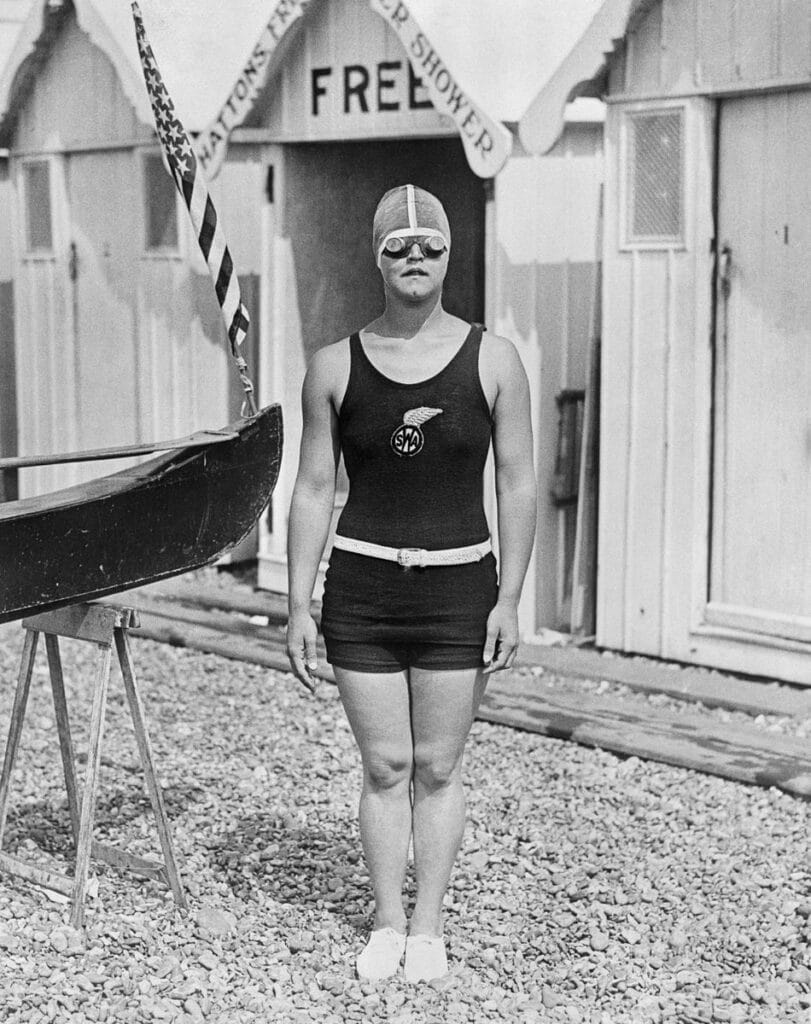
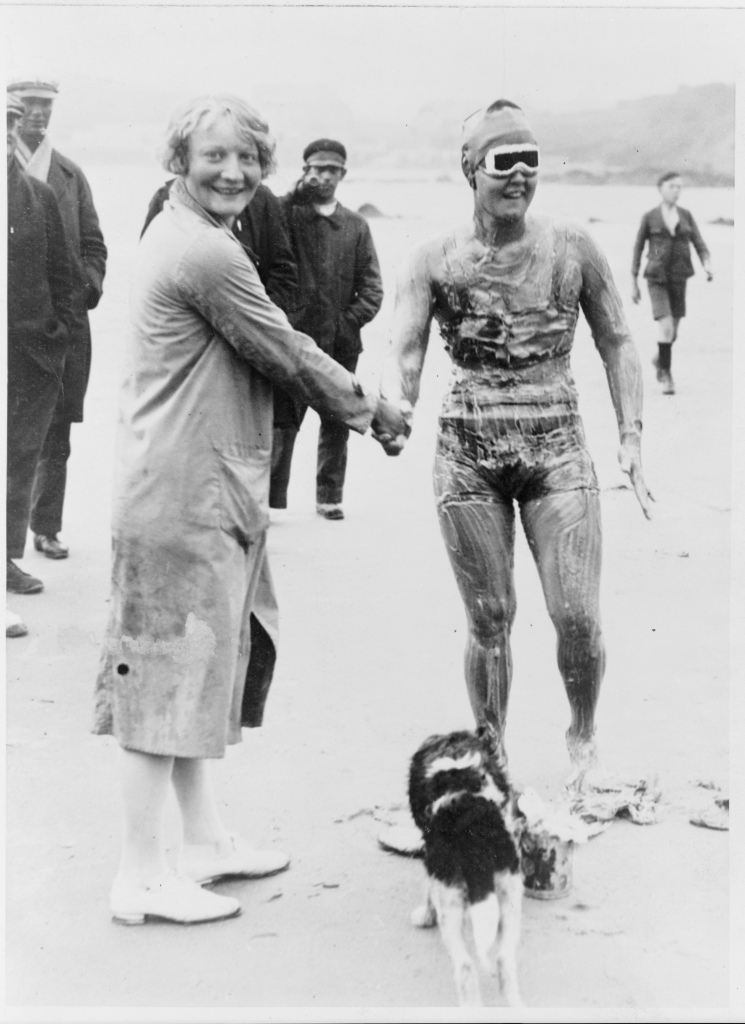
Impact on Women’s Sports and Society
Trudy Ederle’s monumental achievement of swimming across the English Channel in 1926 was not just a personal triumph but a significant milestone for women’s sports and society. Her success epitomized the physical and mental prowess of women, countering societal norms that often questioned their athletic capabilities. By becoming the first woman to conquer the Channel, Ederle shattered preexisting barriers, proving that women could excel at the highest levels of competitive sports.
Ederle’s feat inspired an entire generation of female athletes, opening doors to opportunities previously deemed inaccessible to women. Her success was a clarion call that resonated far beyond the realm of swimming, influencing various other sports. It heralded a new era where women athletes could aspire to achieve greatness in track and field, tennis, gymnastics, and countless other disciplines. This surge in female participation and recognition helped pave the way for institutions like the Women’s Sports Foundation, further legitimizing women’s presence in sports.
Beyond the athletic domain, Trudy Ederle’s achievements resonated profoundly within the broader societal context. Her successful swim across the English Channel served as a vivid illustration that women were equally capable of conquering arduous challenges, thereby contributing to the burgeoning feminist movement. This movement sought to dismantle deeply ingrained gender stereotypes and championed gender equality across all facets of life, including education, politics, and the workplace. Ederle’s example was a powerful narrative that underscored the need for society to revisit and revise its perspectives on women’s abilities and roles.
Moreover, Ederle’s story gained renewed interest through cultural productions such as Disney’s “The Young Woman and the Sea.” These narratives have ensured her legacy endures, continually inspiring new generations. Trudy Ederle’s accomplishments thus reverberate through the annals of history, serving as a beacon of what women can achieve when opportunities are unshackled, and societal constraints are defied.


Challenges and Setbacks
After her record-breaking swim across the English Channel, Trudy Ederle encountered numerous personal and professional challenges that tested her resilience. The societal expectations of the time imposed significant pressures on her as a female athlete. A symbol of both triumph and non-conformity, Ederle had to navigate a public sphere that was often unprepared for her achievements. This was a period where female athleticism was frequently met with skepticism and restrictive norms.
Transitioning from her historic exploit, Ederle faced health issues that complicated her career. Although she maintained an active presence in swimming, recurring injuries and a debilitating fall in 1933 marred her ability to compete at an elite level. These physical setbacks were compounded by the emotional toll of adjusting to life in the public eye and managing the expectations that came with her pioneering status. The early years of Trudy’s post-swim career were marked by efforts to balance her status as a renowned swimmer with the demands of a society less supportive of women in sports.
Ederle also grappled with the commercial and professional dimensions of her success. Opportunities such as performing in aquatic shows and starring in a short-lived Broadway production emerged, reflecting her enduring appeal. However, these ventures often reinforced the societal view of female athletes as entertainers rather than serious competitors. Additionally, Trudy faced the challenge of securing her financial stability, as prize money and sponsorships were considerably less substantial in her era than they are today.
Despite these hurdles, Ederle’s ability to persevere underscored her strength and determination. Her influence extended beyond her sporting achievements, providing a beacon for feminism and women in sports. Her story, which has been immortalized in various narratives like Disney’s adaptation of “The Young Woman and the Sea,” continues to inspire future generations to push past adversities and celebrate the profound impact of women in sports and beyond.
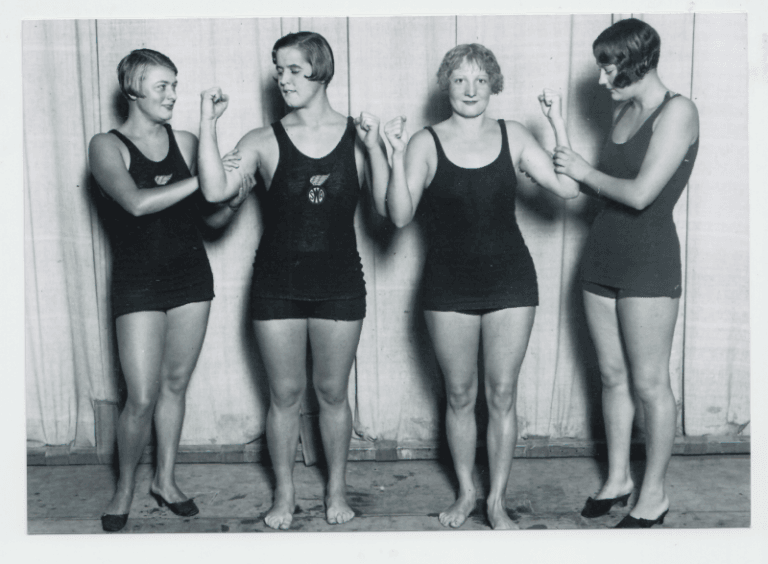
The Legacy of Trudy Ederle
Trudy Ederle’s lasting legacy is a testament to her extraordinary achievements and continues to resonate with waves of influence across generations. As one of the pioneering figures in women’s sports, her contributions extend far beyond the sensational swim across the English Channel in 1926. Ederle’s victory not only secured her a place in the annals of sports history but also garnered numerous honors and recognitions that celebrated her unmatched prowess. She was inducted into the International Swimming Hall of Fame in 1965, affirming her status as a trailblazer in aquatics and heralding her as an inspiration for athletes worldwide.
Ederle’s impact on modern-day female athletes is incalculable. By challenging the prevailing gender norms of her time, she paved the way for countless women in sports to pursue their dreams with confidence and tenacity. Her story is regularly cited in discussions about feminism and women in sports, illustrating how one woman’s daring exploit can create ripples that inspire systemic change. Her life has even been immortalized in literature and media, such as Disney’s adaptation of “The Young Woman and the Sea,” highlighting her cultural and inspirational impact.
Moreover, Trudy Ederle’s legacy serves as a powerful source of motivation for women aiming to break barriers in various aspects of life. Her story echoes through the narratives of women who have followed in her footsteps, striving to achieve greatness in fields as diverse as science, business, and politics. Ederle’s extraordinary journey proves that with determination and resilience, societal limitations can be transcended.
In celebrating Trudy Ederle’s legacy, we not only commemorate her accomplishments but also recognize the enduring influence she exerts on aspiring generations. Her story remains a beacon, illustrating the boundless possibilities that await when courage and ambition unite. Through her remarkable life and athletic achievements, Trudy Ederle continues to inspire and empower women to push beyond their limits and leave an indelible mark on the world.

Review of Disney Plus’ ‘Young Woman and the Sea’
‘Young Woman and the Sea,’ streaming on Disney Plus, is a remarkable portrayal of Trudy Ederle’s life, capturing the perseverance and impact of one of history’s most iconic figures in women’s sports. The film delves into Ederle’s quest to conquer the English Channel, illustrating her dedication not only as an athlete but also as a trailblazer for feminism in sports.
The performances in ‘Young Woman and the Sea’ are noteworthy. The actress playing Trudy delivers a powerful and compelling performance, effectively bringing to life the challenges and triumphs Ederle faced. The supporting cast complements the protagonist’s journey, offering strong portrayals of the friends, family, and trainers who supported her. The interplay among characters helps to enrich the narrative, making it both relatable and inspirational.
Director’s vision focuses on authenticity, successfully weaving historical facts with a gripping storyline. The period setting is meticulously crafted, from the attire to the locations, which subtly enforces the era’s challenges, especially for women in sports. It’s this attention to detail that allows the audience to glimpse into the early 20th century and appreciate the magnitude of Trudy Ederle’s achievements.
The film excels in highlighting the feminist undertones of Ederle’s life, addressing not just her swim across the English Channel but also her broader impact on society. Emphasis on her relentless spirit and the societal barriers she broke through resonates with modern audiences, aligning perfectly with contemporary discussions on women’s empowerment.
Historically, the film remains faithful to the significant moments of Ederle’s career, though certain dramatic liberties are taken to enhance engagement. These deviations, however, do not detract from the overall historical context and instead serve to underscore Ederle’s extraordinary determination and resilience. ‘Young Woman and the Sea’ is not just a film about a sporting exploit; it is a celebration of Trudy Ederle’s indomitable spirit and her lasting legacy in the realm of women’s sports.

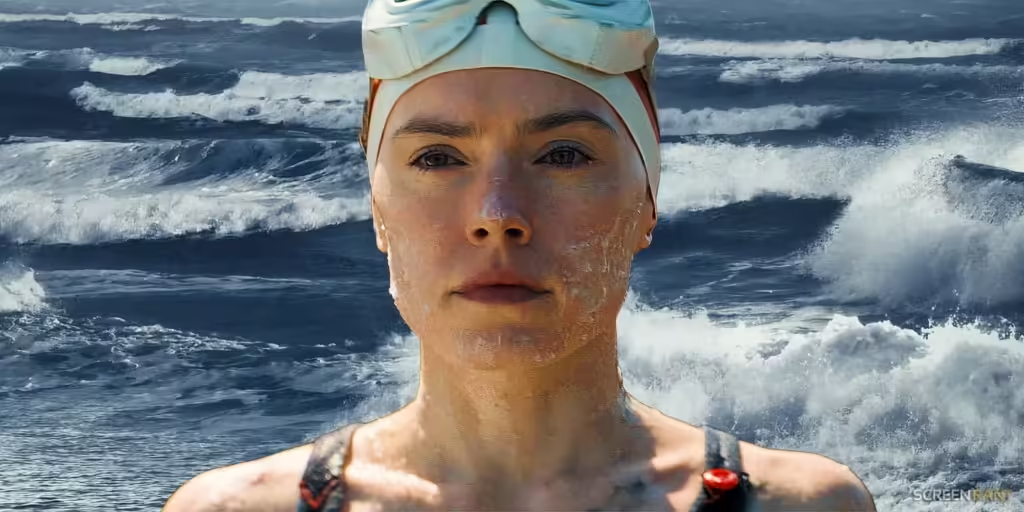
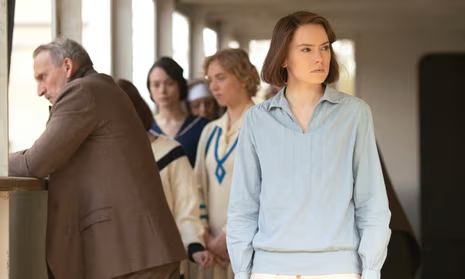

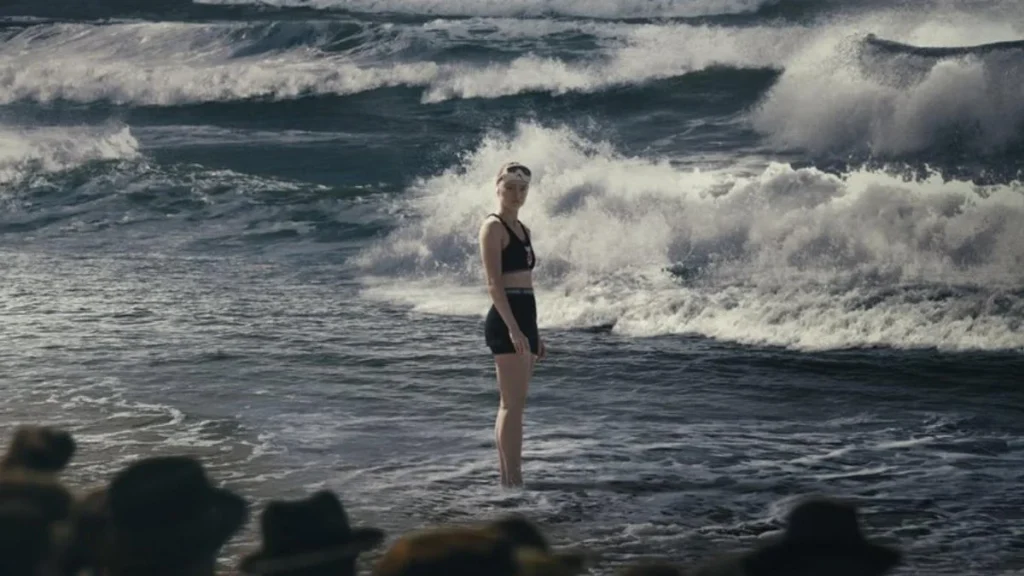
Why Trudy Ederle’s Story Matters Today
The remarkable journey of Trudy Ederle holds significant relevance in today’s society, serving as a beacon of inspiration for both women in sports and the broader feminist movement. Her historic feat of swimming across the English Channel in 1926 was a monumental achievement that transcended the realm of athletics to become a potent symbol of resilience and pioneering spirit.
Ederle’s determination to conquer the Channel came during an era when societal expectations and limitations often constrained women’s aspirations. Her success broke such barriers, demonstrating that women possess the fortitude and capability to achieve extraordinary feats. This serves as a timeless reminder that stereotypes and preconceived notions have no place in limiting what individuals, particularly women, can accomplish.
Today, the impact of Ederle’s exploits can be observed in the increasing visibility and participation of women in various sports. The doors she helped to open have allowed countless others to follow, fostering an environment where female athletes are celebrated and recognized for their talents and contributions. Her story is a testament to the power of perseverance and serves to motivate current and future generations to persist in the face of challenges and adversities.
Moreover, Trudy Ederle’s life is poignantly captured in literature and media, such as in the book “The Young Woman and the Sea” and adaptations produced by entities like Disney. These narratives ensure that her legacy continues to inspire a wide audience, underscoring the importance of recognizing and remembering trailblazers who have significantly paved the way for societal progress.
Ultimately, Ederle’s achievements underscore the importance of recognizing and celebrating the contributions of pioneers in all fields. Her story remains a powerful motivator, encouraging individuals to challenge boundaries and strive for greater heights, making it an invaluable part of our contemporary discourse on equality and empowerment.
